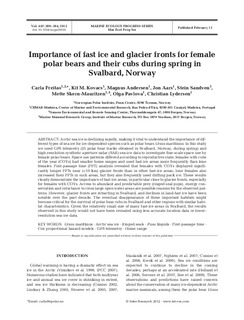| dc.contributor.author | Freitas, Carla | |
| dc.contributor.author | Kovacs, Kit M. | |
| dc.contributor.author | Andersen, Magnus | |
| dc.contributor.author | Aars, Jon | |
| dc.contributor.author | Sandven, Stein | |
| dc.contributor.author | Skern-Mauritzen, Mette | |
| dc.contributor.author | Pavlova, Olga | |
| dc.contributor.author | Lydersen, Christian | |
| dc.date.accessioned | 2012-11-13T18:26:40Z | |
| dc.date.issued | 2012-02-13 | |
| dc.identifier.issn | 0171-8630 | |
| dc.identifier.issn | 1616-1599 | |
| dc.identifier.uri | http://hdl.handle.net/11250/109114 | |
| dc.description.abstract | Arctic sea ice is declining rapidly, making it vital to understand the importance of different
types of sea ice for ice-dependent species such as polar bears Ursus maritimus. In this study
we used GPS telemetry (25 polar bear tracks obtained in Svalbard, Norway, during spring) and
high-resolution synthetic aperture radar (SAR) sea-ice data to investigate fine-scale space use by
female polar bears. Space use patterns differed according to reproductive state; females with cubs
of the year (COYs) had smaller home ranges and used fast-ice areas more frequently than lone
females. First-passage time (FPT) analysis revealed that females with COYs displayed significantly
longer FPTs near (<10 km) glacier fronts than in other fast-ice areas; lone females also
increased their FPTs in such areas, but they also frequently used drifting pack ice. These results
clearly demonstrate the importance of fast-ice areas, in particular close to glacier fronts, especially
for females with COYs. Access to abundant and predictable prey (ringed seal pups), energy conservation
and reluctance to cross large open water areas are possible reasons for the observed patterns.
However, glacier fronts are retracting in Svalbard, and declines in land-fast ice have been
notable over the past decade. The eventual disappearance of these important habitats might
become critical for the survival of polar bear cubs in Svalbard and other regions with similar habitat
characteristics. Given the relatively small size of many fast-ice areas in Svalbard, the results
observed in this study would not have been revealed using less accurate location data or lowerresolution
sea-ice data. | no_NO |
| dc.language.iso | eng | no_NO |
| dc.publisher | Inter-Research | no_NO |
| dc.subject | polar bear | no_NO |
| dc.subject | isbjørn | no_NO |
| dc.subject | seal | no_NO |
| dc.subject | sel | no_NO |
| dc.title | Importance of fast ice and glacier fronts for female polar bears and their cubs during spring in Svalbard, Norway | no_NO |
| dc.type | Journal article | no_NO |
| dc.type | Peer reviewed | no_NO |
| dc.subject.nsi | VDP::Mathematics and natural science: 400::Zoology and botany: 480::Ethology: 485 | no_NO |
| dc.subject.nsi | VDP::Agriculture and fishery disciplines: 900::Fisheries science: 920::Resource biology: 921 | no_NO |
| dc.description.embargo | 2017-02-13 | |
| dc.source.pagenumber | 289-304 | no_NO |
| dc.source.volume | 447 | no_NO |
| dc.source.journal | Marine Ecology Progress Series | no_NO |
| dc.identifier.doi | http://dx.doi.org/10.3354/meps09516 | |
